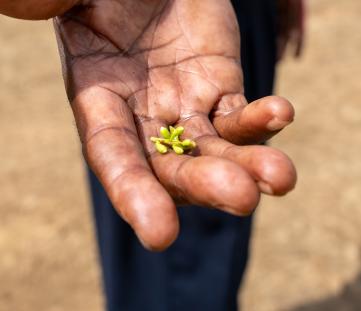ID: N47-553
ID: N47-553
African Mahogany
Khaya senegalensis
Photo
Ghana
00:05 - 29°C
My connections
My ID card
Who am I?
Date of birth
11/30/2022
Name
African Mahogany
Tree
African Mahogany
Where am I located?
Country
Ghana
Place of birth
Mion District
Coordinates
9° 24′ 52.37″ N
0° 3′ 42.05″ W
/-0.061679808846154,9.4145484280769,0/500x333@2x?access_token=pk.eyJ1IjoidG9tbWFzb3NwZXJvbmkiLCJhIjoiY2tnOTE3eW12MDJqazMybXNzOWV1YjloOSJ9.wtGsuDU7XIKjcv2cq8CiXw&logo=false&attribution=false)
My Timeline
The important moments in your tree's life.
Seed
It all starts with a tiny seed, nice and warm in the soil.
Nursery
Your seedling is big enough to be welcomed into one of our nurseries, along with many others.
Planted
We’re here! Your tree has reached its new home: it’s been planted by a smallholder, who’ll take care of it for years to come.
Photo
Strike a pose! Now that it’s big enough, here’s a photo of your tree!
My Gallery
Nursery

Planted
/-0.061679808846154,9.4145484280769,0/500x333@2x?access_token=pk.eyJ1IjoidG9tbWFzb3NwZXJvbmkiLCJhIjoiY2tnOTE3eW12MDJqazMybXNzOWV1YjloOSJ9.wtGsuDU7XIKjcv2cq8CiXw&logo=false&attribution=false)
0° 3′ 42.05″ W
Photo

Curiosity about me
The important moments in your tree's life.
Let's start with introductions
The African Mahogany or Cailcedrat grows in fluvial forests along waterways that extend throughout the savanna. The sweet perfume of the tree’s white flowers are contrasted by its fruit, which varies from cement gray to intense black. It’s planted to provide forage for animals and to obtain healing substances from the bark.
Meaning
Determination
Thanks to its deep roots, the African Mahogany is one of the strongest and most drought-resistant trees of the Khaya species.

How much CO2 I’ll absorb
My estimated CO2 absorption capacity is based on the first 10 years of my life*
Current absorption
- 200 kg
2022
0 kg
2032
-1000 kg
* The tree will continue to absorb CO2 even after the tenth year. Therefore this is a prudent estimate.
How I am useful to local communities

Soil
It improves the quality of the soil thanks to the nitrogen fixation process or it reduces soil erosion, thanks to its extended root system.

Medicine
Its leaves, roots, bark and/or fruits are used in traditional medicine.

Livestock
Its leaves, either fresh or dried-out, are used as food for livestock.
My benefits
30%
Food Security
The trees will bear fruits, some that will be edible immediately and others that can become edible through processing, ensuring food resources over time.
30%
Economic development
The trees' fruits and the products derived from their transformation can be traded in local networks, offering income opportunities.
100%
CO₂ Absorption
During its life cycle, each tree will absorb CO₂. The trees you plant can offset your emissions.
60%
Environmental protection
The trees are planted in agroforestry systems that favor the virtuous interaction between the different species and their positive impact on the environment and on the land.